The Beloniformes are an order of five families of freshwater and marine ray-finned fish: the Adrianichthyidae (ricefish and medakas); Belonidae (needlefish); Exocoetidae (flyingfishes); Hemiramphidae (halfbeaks): and the Scomberesocidae (sauries).[1] With the exception of the Adrianichthyidae, these are streamlined, medium-sized fishes that live close to the surface of the water feeding on algae, plankton, or smaller animals including other fishes. Most are marine, though a few needlefish and halfbeaks inhabit brackish and fresh waters.[2] The order is sometimes divided up into two suborders, the Adrianichthyoidei and the Belonoidei. The Adrianichthyoidei contains only a single family, the Adrianichthyidae. Originally, the Adrianichthyidae were included in the Cyprinidontiformes and assumed to be closely related to the killifish, but a closer relationship to the beloniforms is indicated by various characteristics including the absence of the interhyal, resulting in the upper jaw being fixed or nonprotrusible. The Belonoidei may also be further subdivided into two superfamilies, the Scomberesocoidea and the Exocoetoidea. The Scomberesocoidea contains the Belonidae and Scomberesocidae, while the Exocoetoidea comprises the Exocoetidae and Hemiramphidae.[3] However, newer evidence finds that the flyingfishes are nested within the halfbeaks, and the needlefish and sauries are nested within the subfamily Zenarchopterinae of the family Hemiramphidae, which has been recognized as its own family. The sauries are also nested within the family Belonidae.[4] The beloniforms display an interesting array of jaw morphologies. The basal condition in the order excluding the ricefishes is an elongated lower jaw in juveniles and adults as represented in halfbeaks. In the needlefish and sauries, both jaws are elongated in the adults; the juveniles of most species develop through a "halfbeak stage" before having both jaws elongated. The elongated lower jaw is lost in adults and is lost in most juveniles in the flyingfishes and some halfbeak genera.[4] References
Retrieved from "http://en.wikipedia.org/" |
|

